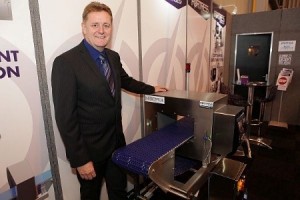Fortress: Sensitive about sphere size
 The standard technique for measuring the sensitivity of food inspection metal detectors is to use metal test spheres. Although this type of spherical testing tool is typically expressed by diameter in millimetres, in the real world metal contaminants are more likely to be non-spherical or an irregular shape. Phil Brown, Sales Director at Fortress Technology explains why spheres are used and why a size detection improvement as little as 0.5mm can dramatically cut the risk of metal fragments entering the production chain.
The standard technique for measuring the sensitivity of food inspection metal detectors is to use metal test spheres. Although this type of spherical testing tool is typically expressed by diameter in millimetres, in the real world metal contaminants are more likely to be non-spherical or an irregular shape. Phil Brown, Sales Director at Fortress Technology explains why spheres are used and why a size detection improvement as little as 0.5mm can dramatically cut the risk of metal fragments entering the production chain.
“The rationale for using spheres to ascertain the system’s sensitivity level is because they are the same shape from every aspect when passing through the metal detector,” explains Phil. “Realistically, metal contaminants are more likely to be a piece of swarf, metal shard or narrow wire than a perfectly formed ball.
“Furthermore, the signal produced from a wire shape will vary greatly depending on the type of metal it is and on its angle when it passes through the detector. This is known as orientation effect. For example, a stainless steel wire that passes through the aperture upright or sideways generates a higher signal than a straight. In the worst case a wire may produce a signal no bigger than a sphere of the same size as the diameter of the wire.”
Metal detector manufacturers naturally use spherical test samples to showcase advances in sensitivity, although visualising what a 50% improvement in metal detection sensitivity actually equates to is challenging. “Our customers express regular confusion and find it difficult to picture what these numbers and percentage improvements really mean in terms of a true contaminant,” says Phil.
The relationship between the detection of wire and sphere size is very complex and changes depending on material size, presentation and type. To cut through the confusion the Fortress team complete hands-on demonstrations with customers using soft modelling material. “If you were to roll out a 3.5mm stainless steel metal sphere between your hands – currently the standard Code of Practise for a block of cheese about 75mm high, it could equate to a wire length of 30 cm, depending on the diameter of the wire. Realistically, something of this size is likely to protrude from the product and would be relatively easy to spot with the naked eye. It’s when smaller wires or swarf slivers are embedded into a product where the sensitivity of your metal detector really comes into play.”
Putting this into context, Phil says that an improvement in sphere size of 0.5mm can equate to wire length contaminant measuring 2.5cm. The smaller the spherical size, the shorter the wire length.
The type of metal contaminant also needs to be factored in. Most detectors will exhibit a different level of sensitivity for the three main groups – ferrous (such as iron or steel), non-ferrous (including copper or brass) and stainless steel. “Because metal detectors work by spotting materials that create a magnetic or electrical disturbance as they pass through an electromagnetic field, stainless steel is typically the most troublesome,” highlights Phil.
Widely in food preparation and production areas, stainless steel comes in various grades. Unlike ferrous and non-ferrous metals, stainless steel is usually non-magnetic and a poor electrical conductor. Consequently, a sphere of stainless steel hidden in a dry product typically needs to be 50% larger than a ferrous sphere to generate a similar signal size. This disparity can rise to 300% in wet products, such as ready meals, meat, fish, sauces, preserves and bread, because moisture acts as a conductive and the metal detection signal can be swamped by product effect.
The accepted industry threshold for stainless steel sphere size is currently 3.5mm. Fortress, however, can now achieve upward of 2.2mm with its new Interceptor metal detector range. “From a risk management perspective this makes a huge difference and goes a long way to protecting brand reputation,” notes Phil. “Although there are many variables which can affect a metal detector’s performance, including orientation of contaminants, the type of product passing under the detector, product size and the speed of the line. However, machine sensitivity remains a solid and reliable gauge,” he adds.
Fortress has recently updated their food safety metal detection guide, clearly explaining all the basics behind the technology and how to prepare for a food safety audit.
Fortress Technology was established in 1996 and since then the company has blossomed into a global enterprise with main offices in Canada, the UK, and Brazil serving North America, Europe, and Latin America.


































